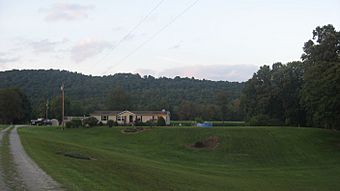Adams County Paleo-Indian District facts for kids
Quick facts for kids |
|
|
Adams County Paleo-Indian District
|
|

View from the south
|
|
| Location | North of U.S. Route 52 near Sandy Springs, Ohio |
|---|---|
| Area | 175 acres (71 ha) |
| NRHP reference No. | 74001389 |
| Added to NRHP | October 17, 1974 |
The Adams County Paleo-Indian District is a very old archaeological site (a place where people study human history) located near Sandy Springs in Adams County, Ohio, United States. It is a special place where scientists have found many clues about the lives of ancient people.
Contents
Discovering Ancient Life
This site was a popular spot for groups of Paleo-Indians about 10,000 years ago. Paleo-Indians were some of the first people to live in North America. They visited this area many times.
They liked the location because it was near salt springs. These springs attracted many animals, making it a great place for hunting.
Clues from the Past
Scientists have found many artifacts (objects made by humans) at the site. These artifacts are mostly found in small piles called middens. Each midden probably shows where a single group of people camped.
Some of the tools found include special types of stone tools. These are called gravers, scrapers, and projectile points. Projectile points are the tips of spears or arrows.
In 1982, a report said that over seventy "fluted points" were found here. These are also known as Clovis points. Clovis points are a special type of spearhead used by early Paleo-Indians.
A Rare and Important Place
Finding so many tools in one place makes the Adams County site very important. Most Paleo-Indian discoveries are just single tools found alone. This site, also called "Sandy Springs," is unusually large and complex.
Another similar large site is the Welling Site in Coshocton County, Ohio. These large sites help us understand how ancient people lived together.
The geology (the study of Earth's rocks and soil) of southern Adams County was very important to these early people. This area has a mix of shale and limestone bedrock. This is similar to the Kentucky Bluegrass area.
This made it a natural path for large herds of animals to travel. Paleo-Indian hunters learned to use this area to watch for and hunt these animals. The large river nearby would have made the animals move slowly, making them easier to hunt.
Why This Site is Special
The Adams County Paleo-Indian Archeological District is very valuable. It is a well-preserved example of what life was like during the Paleo-Indian period.
Scientists believe that only a small part of the site has been explored so far. There is likely much more to discover underground.
Because of its great importance, the site was added to the National Register of Historic Places in 1974. This means it is a place that is officially recognized for its historical value. The protected area covers about 175 acres (71 ha).



